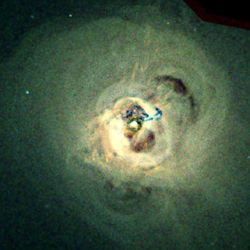December 1, 2005
CXC RELEASE: 05-09
Scientists using NASA's Chandra X-ray Observatory have discovered evidence of energetic plumes - particles that extend 300,000 light years into a massive cluster of galaxies. The plumes are due to explosive venting from the vicinity of a supermassive black hole, and they provide dramatic new evidence of the influence a black hole can have over intergalactic distances.
"In relative terms, it is as if a heat source the size of a fingernail affects the behavior of a region the size of Earth," said Andrew Fabian of Cambridge University, U.K. Fabian is lead author of a report on this research that will appear in an upcoming issue of the Monthly Notices of the Royal Astronomical Society.
Fabian's group discovered the plumes by studying data from 280 hours (more than 1 million seconds) of Chandra observations of the Perseus cluster, the longest X-ray observation ever taken of a galaxy cluster. The cluster contains thousands of galaxies immersed in a vast cloud of multi-million degree gas with the mass equivalent of trillions of suns.
The plumes showed up in the X-ray data as low pressure regions in the hot gas extending outward from the giant galaxy in the center of the cluster. The low gas pressure measured in the plumes is likely the result of the displacement of the gas by bubbles of unseen high-energy particles.
The bubbles appear to be generated by high-speed jets blasting away from the vicinity of the giant galaxy's supermassive black hole. Individual bubbles seen in the inner regions expand and merge to create vast plumes at larger distances.
"The plumes show that the black hole has been venting for at least 100 million years, and probably much longer," said co-author Jeremy Sanders also of Cambridge University.
The venting produces sound waves which heat the gas throughout the inner regions of the cluster and prevent the gas from cooling and making stars at a large rate. This process has slowed the growth of the central galaxy in the cluster, NGC 1275, which is one of the largest galaxies in the universe.
NASA's Marshall Space Flight Center, Huntsville, Ala., manages the Chandra program for the agency's Science Mission Directorate. The Smithsonian Astrophysical Observatory controls science and flight operations from the Chandra X-ray Center in Cambridge, Mass.
Images and additional information about Chandra are available at:
For more information about NASA and agency programs on the Web, visit:
MEDIA CONTACTS
Steve Roy
Marshall Space Flight Center, Huntsville, Ala.
(256) 544-6535
Megan Watzke
Chandra X-ray Center, Cambridge, Mass.
(617) 496-7998





